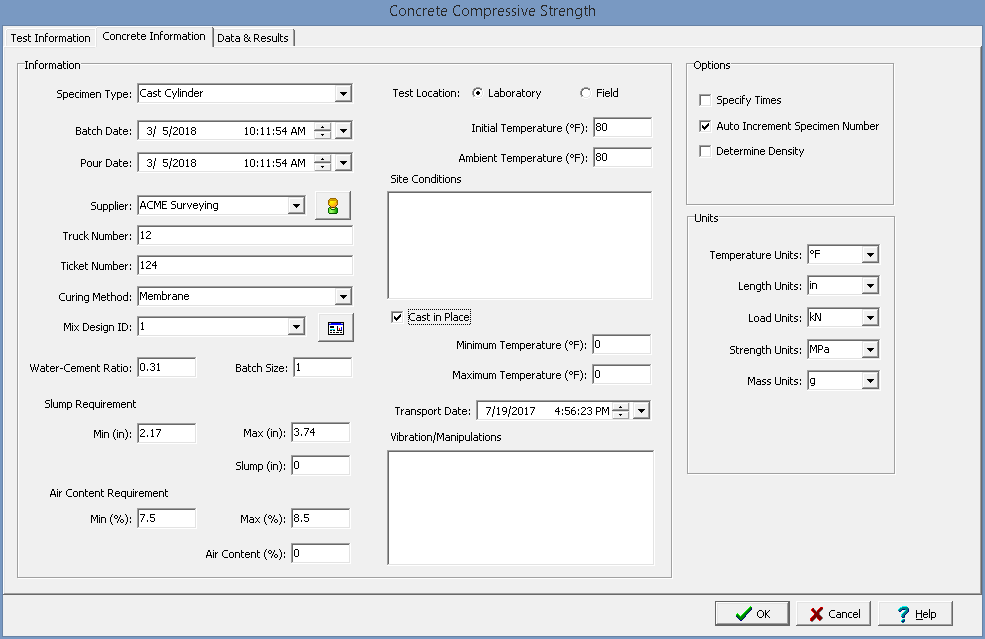|
<< Click to Display Table of Contents >> Concrete Information Tab |
  
|
|
<< Click to Display Table of Contents >> Concrete Information Tab |
  
|
This tab is used to specify the information for the concrete specimens.

The following can be entered and displayed on this tab:
Information
Specimen Type: This is used to select the type of specimen. It can either be cast cylinder, cored cylinder, or concrete cube.
Batch Date: This is used to specify the date and time the concrete was batched.
Pour Date: This is used to specify the date and time the concrete was poured.
Supplier: This is used to select the concrete supplier from a predefined list of suppliers. To get detailed information about the supplier click on the button on the right.
Truck Number: This is used to specify the truck number delivering the concrete.
Ticket Number: This is used to specify the ticket number for the concrete.
Curing Method: This is used to select the curing method from a predefined list of curing methods.
Mix Design ID: This is used to select the mix design ID from a predefined mix designs. A datasheet showing the details of the mix design can be displayed by clicking on the button on the right.
Water-Cement Ratio: This is used to specify the water-cement ratio of the concrete. If it has not been already specified it will be filled in when the mix design is selected.
Batch Size: This is used to specify the size of the concrete batch. If it has not been already specified it will be filled in when the mix design is selected.
Min Slump Requirement: This is used to specify the minimum slump requirement. If it has not been already specified it will be filled in when the mix design is selected.
Max Slump Requirement: This is used to specify the maximum slump requirement. If it has not been already specified it will be filled in when the mix design is selected.
Slump: This is used to specify the slump of the concrete.
Min Air Content Requirement: This is used to specify the minimum air content requirement. If it has not been already specified it will be filled in when the mix design is selected.
Max Air Content Requirement: This is used to specify the maximum air content requirement. If it has not been already specified it will be filled in when the mix design is selected.
Air Content: This is used to specify the air content of the concrete.
Test Location: This is used to select the test location, either laboratory or field.
Initial Temperature: This is used to specify the initial temperature.
Ambient Temperature: This is used to specify the ambient temperature.
Site Conditions: This is used to describe the site conditions.
Cast in Place: Check this box if the concrete was cast in place using special molds attached to formwork.
Minimum Temperature: If the concrete specimen is cast in place, this is used to specify the minimum temperature at the job site.
Maximum Temperature: If the concrete specimen is cast in place, this is used to specify the maximum temperature at the job site.
Transport Date: If the concrete specimen is cast in place, this is used to specify the date and time the concrete was transported from the job site.
Vibrations/Manipulations: If the concrete specimen is cast in place, this is used to describe any internal vibrations or manipulations of the fresh concrete.
Options
Specify Times: Check this box to specify the times of the compressive strength measurements.
Auto Increment Specimen Number: Check this box to automatically increment the specimen number for compressive strength measurements.
Determine Density: Check this box to calculate the density for each compressive strength measurement.
Calculate Volume: If the density is being determined, check this box to calculate the volume based on the specify dimensions otherwise the volume can be specified.
Units
Temperature Units: This is used to select the units for temperature.
Length Units: This is used to select the units for length.
Load Units: This is used to select the units for load.
Strength Units: This is used to select the units for strength.
Mass Units: This is used to select the units for mass.
Volume Units: If the density is being determined, this is used to select the units for volume.
Density Units: If the density is being determined, this is used to select the units for density.